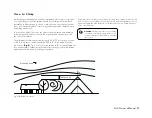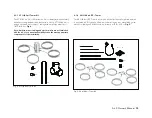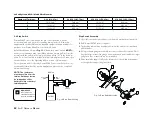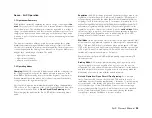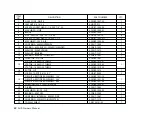
Air X Owner’s Manual
25
Regulation:
As Air X produces power and the battery voltage rises to the
regulation set point voltage, Air X will go into “regulation.” At that point it
stops producing power and the blade rpm will lower dramatically (almost
stopping). There is a time delay of up to one minute, from when the Air X
regulation set point – this is often referred to as the
cut-in voltage
. When
the cut-in voltage is reached, the blades will resume spinning in response
to the available wind. Regulation mode is indicated by the Air X LED
Stall Mode:
(wind speeds and times listed below are approximate) Stall
500 – 700 rpm. Air X will enter stall mode when a wind speed of 35 mph
mode is marked by a dramatic reduction in turbine speed to approximately
(15.6 m/s) is sensed, and it will remain in stall mode until the speed drops
to 32 mph (14 m/s). If a wind speed of 50 mph (22 m/s) is detected, the
turbine will completely shut down for 5 minutes.
When in stall mode the Air X LED will blink quickly – approximately 10
times per second.
Braking Mode:
Air X may be placed in braking mode by directly short-
ing the turbine positive and negative wires together or by the use of a
stop switch. The stop switch first disconnects the turbine from the battery
and then shorts the positive and negative wires. In very strong winds the
blades may rotate slowly even with the switch activated.
No Load Operation /Open Circuit /Free Spinning:
Air X will spin
freely if disconnected from an electrical load. This results in a cycle of
rapid blade speed followed by rapid braking – this mode of operation may
accelerate wear of the turbine and is also non-productive. To turn Air X
off for short periods of time
ower recommends using a
properly installed switch. If your Air X will be shut down for an extended
period of time Primus Wind Power recommends lowering the turbine
completely or securing the blades to prevent rotation.
Seven - Air X Operation
7-1 Operational Summary
Wind turbines operate by capturing the kinetic energy of moving air:
the
wind
. They convert it to rotational motion to turn an alternator that produc-
es electrical power. The electrical power must be regulated to a voltage to
charge the system batteries, and there must be a system to prevent over-
charging the batteries and resume charging as the battery voltage drops.
A means to protect the wind turbine from extreme wind damage must also
be provided.
The Air X accomplishes all these goals by incorporating a three phase
brushless permanent magnet alternator and microprocessor controlled
electronics to optimize its power production capability. The microprocessor
continuously adjusts the loading of the alternator to keep the blades oper-
ating at their optimal angle of attack. The result:
•
higher power production
•
higher blade efficiency
•
reduced sound emissions
7-2 Operating Modes
Charging:
With Air X connected to batteries and with the voltage below
voltage matches the regulation set point.
Note that Air X requires a minimum battery bank voltage (approximately
10.5 volts on a 12-volt system) or the controller will behave as if an open
circuit condition exists. Refer to
Open Circuit/Free Spinning
section.
When charging the batteries, the Air X LED will be continuously illumi-
nated.
the voltage regulation set point, the blades will spin in response to the
wind. Blades will be spinning before the turbine begins to export power.
With an available wind, the blades will continue to spin until the battery
will remain in regulation until the battery voltage drops slightly below the
Primus Wind P
blinking at a rate of approximately once per second.

